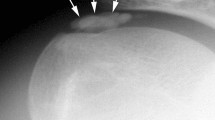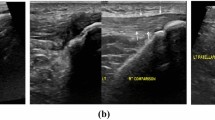Abstract
Partial-thickness bursal-surface tears of supraspinatus tendon may be missed on preoperative investigations and can be overlooked at surgery if not specifically sought. The authors describe an arthroscopic sign to detect these tears, when they involve more than half the tendon fibres, from the articular-side of the joint. The “paraglider-wing” sign, visualized during diagnostic glenohumeral arthroscopy, is demonstrated as an upward bulge of the capsulo-tendinous layer through the bursal-surface tear, under pressure of the inflow fluid. A positive sign indicates (1) presence of a partial-thickness bursal-side tear of the supraspinatus tendon, (2) significant depth (stage II or III) of the tear, and (3) the medial extent of the tear along the length of the tendon. A meticulous subacromial bursoscopy and excision of the bursa is then performed to visualize the tear from the subacromial space. Repair of the tear is performed with a double-row suture anchor fixation technique; the medial row of sutures is passed through the intact region of the tendon using the “paraglider-wing” sign as a guide.




Similar content being viewed by others
References
Budoff JE, Nirschl RP, Guidi EJ (1998) Current concepts review-Debridement of partial-thickness tears of the rotator cuff without acromioplasty. Long-term follow-up and review of literature. J Bone Joint Surg Am 80:733–748
Ellman H (1990) Diagnosis and treatment of incomplete rotator cuff tears. Clin Orthop Relat Res 254:64–74
Fukuda H (2000) Partial-thickness rotator cuff tears: a modern view on Codman’s classic. J Shoulder Elbow Surg 9:163–168
Levigne C, Walch G (1997) Partial-thickness tears of the superficial layer of the supraspinatus: a study of 34 cases. In: Gazielly DF, Gleyze P, Thomas T (eds) The cuff. Paris, Elsevier, Amsterdam, pp 238–242
Yamanaka K, Fukuda H (1991) Ageing process of the supraspinatus tendon with reference to rotator cuff tears. In: Watson MS (ed) Surgical disorders of the shoulder. Ediburgh, Churchill Livingstone, pp 247–258
Author information
Authors and Affiliations
Corresponding author
Additional information
Each author certifies that he has no commercial associations (e.g. consultancies, stock ownership, equity interest, patent/licensing arrangements, etc.) that might pose a conflict of interest in connection with the submitted article.
Rights and permissions
About this article
Cite this article
Bhatia, D.N., van Rooyen, K.S. & de Beer, J.F. The “paraglider-wing” sign: an arthroscopic indicator of partial-thickness bursal-surface tears of the supraspinatus tendon. Knee Surg Sports Traumatol Arthrosc 15, 790–793 (2007). https://doi.org/10.1007/s00167-006-0228-1
Received:
Accepted:
Published:
Issue Date:
DOI: https://doi.org/10.1007/s00167-006-0228-1




